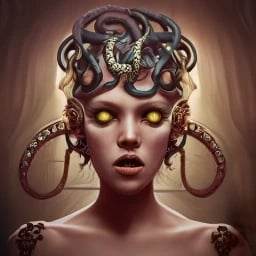Gorgons, Fascinating Creatures From Greek Mythology
9th June 2023
Categorized Under: Myths and Legends from Around the World
Comments Off on Gorgons, Fascinating Creatures From Greek Mythology
GORGONS, FASCINATING CREATURES FROM GREEK MYTHOLOGY
Greek mythology refers to the collection of ancient Greek stories, legends, and myths that were passed down orally through generations. It encompasses a vast array of narratives about gods, goddesses, heroes, and mythical creatures, offering explanations for natural phenomena, human behavior, and the origins of the world. It was an integral part of ancient Greek culture and religion. It provided the Greeks with a framework through which they understood the world around them and their place in it. The myths were woven into the fabric of their daily lives, influencing their beliefs, rituals, and art.
The Greek pantheon consisted of a multitude of gods and goddesses who governed various aspects of human existence and natural phenomena. Some of the most well-known deities include Zeus, the king of the gods; Athena, the goddess of wisdom; Aphrodite, the goddess of love and beauty; and Poseidon, the god of the sea. Each deity had unique attributes, powers, and personalities, and they often interacted with humans, sometimes helping or punishing them.
Greek mythology also featured numerous heroes, mortal individuals with exceptional abilities, and the favor of the gods. These heroes, such as Heracles (Hercules), Perseus, and Achilles, embarked on grand quests, fought mythical creatures, and achieved great feats.
The myths of Greek mythology explain the origins of the world and its natural phenomena through stories of creation, such as the birth of the cosmos from Chaos and the Titans. They also explore the complexities of human nature, showcasing the virtues, flaws, and moral dilemmas faced by humans and gods alike. The myths often conveyed lessons, warnings, and cultural values, offering insights into the human condition.
THE GORGONS:
In the world of Greek mythology, there were many fearsome creatures that captured the imaginations of people for centuries. But few were as terrifying and awe-inspiring as the Gorgons – three sisters with snake-like hair and the power to turn people to stone with their gaze.
A Gorgon is a creature from Greek mythology that is usually depicted as a woman with snakes for hair. In some stories, they also have wings and sharp fangs. Gorgons are known for their ability to turn people to stone just by looking at them, and they are usually portrayed as very scary and dangerous creatures.
There are three Gorgons in Greek mythology – Medusa, Stheno, and Euryale:
Medusa: Medusa is the most well-known of the three Gorgon sisters. She was originally a beautiful maiden with golden hair, but she incurred the wrath of the goddess Athena. According to one version of the myth, Medusa caught the attention of Poseidon, the god of the sea, and they had a clandestine encounter in Athena’s temple. Outraged by this sacrilege, Athena transformed Medusa’s hair into snakes and made her face so terrifying that anyone who looked upon her would be turned to stone.
Medusa’s most famous appearance in mythology is in the story of Perseus, who was tasked with slaying her. With the help of Athena and Hermes, Perseus managed to behead Medusa by using a mirrored shield to avoid direct eye contact. Her severed head, even in death, retained its power to turn people to stone. Perseus later used it as a weapon, turning enemies to stone by showing them Medusa’s severed head.
Stheno: Stheno was the eldest of the three Gorgon sisters and the only one who was said to be immortal. Unlike her sister Medusa, Stheno was not depicted with snakes for hair in some accounts. She, along with Euryale, was considered a monstrous and ferocious creature. There is not much specific mythology associated with Stheno outside of her role as one of the Gorgons.
Euryale: Euryale was the middle sister of the Gorgons. Like her sisters, she had a terrifying appearance and snakes for hair. While not as well-known as Medusa, Euryale did play a role in Greek mythology. Alongside her sister Stheno, she was believed to be a guardian of the Gorgonian treasure and resided on the far western edge of the world, near the entrance to the Underworld. According to some myths, the hero Perseus encountered both Euryale and Stheno while on his quest to slay Medusa.
MEDUSA’S LEGEND:
Long ago, in the realm of ancient Greece, there lived three fearsome sisters known as the Gorgons. Their names were Medusa, Stheno, and Euryale. Born from the ancient sea gods Phorcys and Ceto, the Gorgons possessed a monstrous appearance that struck terror into the hearts of all who gazed upon them.
Medusa, the youngest and most famous of the three, was once a beautiful maiden with flowing golden locks. However, she incurred the wrath of the goddess Athena. Legend says that Medusa caught the attention of Poseidon, the god of the sea, and they shared a secret encounter in Athena’s sacred temple. Enraged by this act of sacrilege, Athena transformed Medusa’s lovely hair into writhing serpents and cursed her with a visage so hideous that any who looked upon her would be turned to stone.
With her new monstrous form, Medusa joined her sisters, Stheno and Euryale, in their secluded lair, hidden far away in the treacherous depths of a dark cave. Together, they became the epitome of terror and chaos. Their eyes glowed with an unnerving green hue, and their hissing voices echoed through the shadows.
The Gorgons’ fearsome powers were renowned throughout the land. Their gaze alone could turn warriors, heroes, and even the mightiest creatures into lifeless stone statues. Many brave souls sought to challenge the Gorgons, eager to prove their heroism and claim victory over the monstrous trio. However, few dared to venture into their lair, for the mere thought of facing the Gorgons struck fear into the hearts of mortals.
One such hero who dared to face the Gorgons was Perseus, a demigod born of Zeus and a mortal woman. Armed with a reflective shield from the goddess Athena and winged sandals from Hermes, Perseus embarked on a perilous quest to slay the dreadful Medusa and claim her head as a weapon.
Using his wits and the aid of the gods, Perseus navigated the treacherous path to the Gorgon sisters’ lair. With his shield, he cleverly avoided direct eye contact with Medusa, catching only her reflection. With a swift stroke of his sword, Perseus severed Medusa’s head from her monstrous body.
Even in death, Medusa’s head retained its fearsome power. Perseus wisely kept it hidden away, knowing the danger it posed. The severed head became a formidable weapon, capable of turning any adversary into stone with a single glance.
Thus, the legend of the Gorgons was forever etched into Greek mythology. Medusa, with her serpentine hair and petrifying gaze, became an enduring symbol of terror and caution. The myth of the Gorgons serves as a reminder that even the most beautiful can fall from grace, and that sometimes, courage and cunning are required to overcome the most formidable challenges.
WHO WAS PERSEUS?
Perseus is a famous figure in Greek mythology, known as the slayer of the Gorgon Medusa. He was a demigod, meaning he was the son of a mortal woman, Danaë, and the god Zeus, who took the form of a golden shower to impregnate her.
Perseus’ early life was marked by a series of perilous adventures. When King Polydectes, who desired Danaë, sought to get rid of Perseus, he devised a plan. Polydectes commanded Perseus to bring him the head of the Gorgon Medusa as a wedding gift. Guided by the gods, Perseus embarked on this daunting quest.
Equipped with various magical items bestowed upon him by the gods, including a mirrored shield from Athena, a pair of winged sandals from Hermes, a cap of invisibility from Hades, and a sickle-shaped sword from Zeus, Perseus set out on his journey.
With the aid of Hermes and Athena, Perseus found the lair of the Gorgon sisters—Medusa, Stheno, and Euryale. Using the reflective shield, he avoided Medusa’s gaze and beheaded her with a single stroke of his sword. From Medusa’s severed neck sprang the winged horse Pegasus and the golden warrior Chrysaor.
Perseus later had various adventures, including saving Princess Andromeda from a sea monster and participating in the Olympic Games. Eventually, he returned to his homeland of Argos, where he confronted King Polydectes. Using Medusa’s head, he turned the king and his supporters into stone, thus avenging his mother.
Perseus then became a legendary hero, known for his bravery and cleverness. He played a role in founding the city of Mycenae and the dynasty of the Perseids. Perseus married Andromeda and had many children, including the hero Heracles (Hercules).
Perseus’ story has been celebrated in various works of literature, art, and film, making him one of the most famous heroes of Greek mythology. His adventures demonstrate the triumph of courage, resourcefulness, and divine assistance in the face of seemingly insurmountable challenges.
Click here to read Kidsinco’s Myths and Legends from Around the World
Click here to read Kidsinco’s Complete List of Playscripts
Please read our Terms of Use
Instagram: @kidsinco



